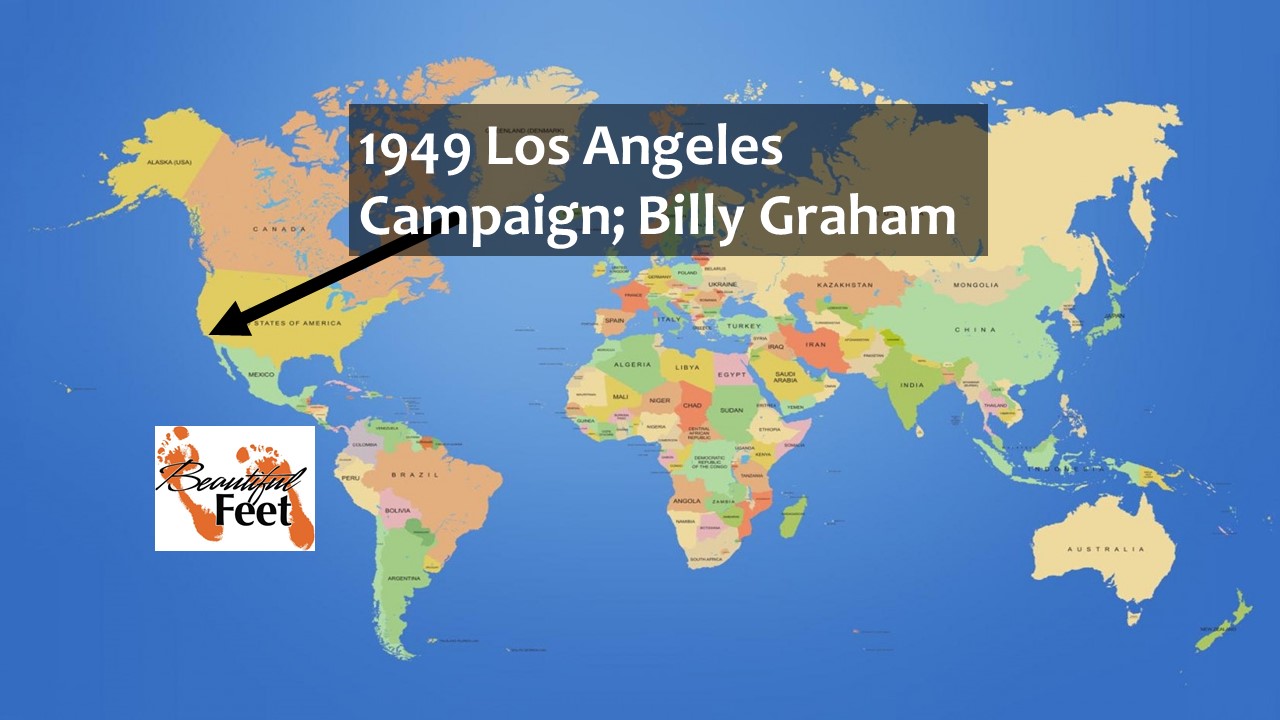
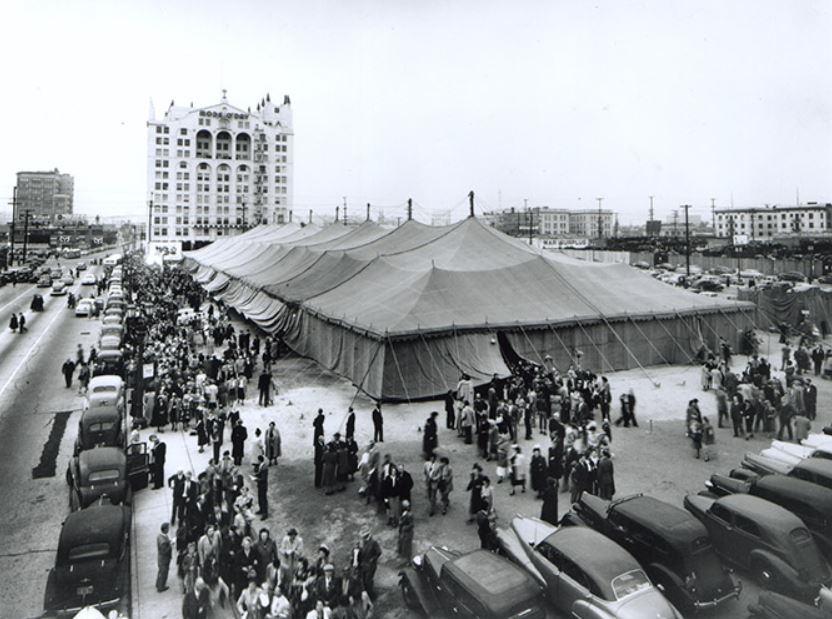
Tent during the 1949 Los Angeles Evangelistic Campaign: Photo used with permission of BGEA. www.billygraham.org
Introduction
Evangelist Billy Graham (1918-2018) is a man most would say needs no introduction. Here are a few of the phrases that have been used to distinguish him:
► “Among the most influential Christian leaders of the 20th century”
► “Pastor to Presidents”
► “America’s Protestant Patriarch”
► “Greatest Living American”
► He has been in the Top 10 on Gallup’s “Most Admired Man” list 61 times.
This revival story is going to focus on the 1949 Los Angeles Campaign, in which Billy Graham was the guest evangelist. It was this evangelistic event which most would say brought Graham national and international fame. The 72 services conducted during that evangelistic event occurred between September 25 and November 20, 1949. During those 8 weeks, thousands were saved and thousands came back to the Lord.
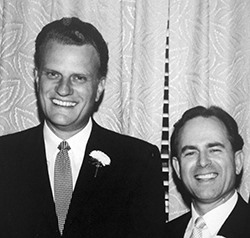
Billy Graham and Stephen Olford
Foundation to Billy Graham’s Success
Billy Graham was converted at age 16, in 1934. While in Bible College, he preached his first sermon at Bostwick Baptist Church in 1937. The beginning of his ministry success and rise to international fame, however, occurred after he spent several days praying and searching the Scriptures with Stephen F. Olford, who Graham said was
the man who most influenced my ministry.
Graham arrived in the United Kingdom in the fall of 1946 for a six-month evangelistic tour, and while conducting services in Wales, he attended a youth conference in which Stephen Olford preached about his experience of being “filled with the Spirit” and surrendering his life to God. Graham approached Olford after his sermon and asked to spend time with him, to search the Scriptures together and pray.
On their second day together, after Olford shared with Graham about how the Holy Spirit had completely turned his life inside out following an experience he had with the Holy Spirit, Graham, with tears in his eyes, said,
Stephen, I see it. That’s what I want. That’s what I need in my life.
The two then kneeled and after having “prayed through,” Graham said,
My heart is so flooded with the Holy Spirit.
They then began praying some more, as well as praising and laughing, and as Graham was walking back and forth across the room, he was crying out,
I have it. I’m filled. This is the turning point in my life.
When they went to the church that evening, Olford said that the building that previously was “only moderately filled the night before was packed to the doors.” And the preaching of Billy Graham had changed as well, because
…the normally unemotional Welsh jammed the aisles as soon as he [Graham] began the invitation.
Olford said that his “own heart was so moved by Billy’s authority and strength that I could hardly drive home.” When he did arrive home, and entered the door, Olford recalls,
My father looked at my face and said, ‘What on earth has happened to Billy Graham? The world is going to hear from this man. He is going to make his mark in history.’
Graham’s experience with the Holy Spirit can be likened to that of Charles Finney, D.L. Moody, and many others, whose ministries were catapulted after their baptism with power.
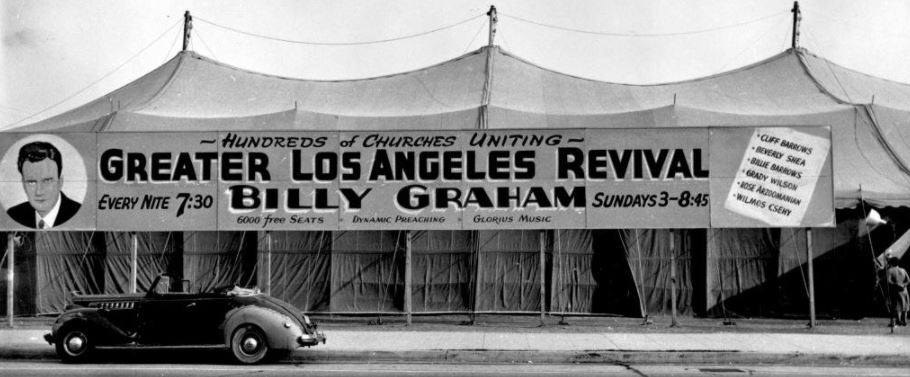
Los Angeles Tent: Photo used with permission of BGEA. www.billygraham.org
Extraordinary Prayer in Preparation for the Los Angeles Campaign
Every revival begins with extraordinary prayer, and what took place at the Billy Graham Campaign in Los Angeles was also preceded by extraordinary prayer. Here are some of the prayer efforts that were initiated:
► A ministers’ prayer conference was conducted.
► Prayer groups were established in churches.
► Hundreds of homes throughout Los Angeles became prayer centers.
► Churches and other Christian organizations formed prayer groups.
► One church organized 58 prayer groups.
► There was around-the-clock prayer by groups of men and women.
► All-night prayer meetings were held in the smaller tent next to the main tent.
What Happened
A group of businessmen were leading an organization called “Christ for Greater Los Angeles.” This organization would occasionally conduct evangelistic events in the city, in association with around 200 area churches. This organization had asked Billy Graham to be the evangelist for the event they were planning for 1949. Graham didn’t immediately accept the offer, as he felt so strongly that the Lord was behind it that he said that the organization would have to first meet three conditions:
1. Increase the number of supporting churches and denominations.
2. Increase the financial budget from $7,000 to $25,000 and
3. Set up a tent to seat 5,000 rather than the proposed 2,500-seat tent.
The organization agreed to the terms and the event was scheduled to start the last week of September and run for three weeks.
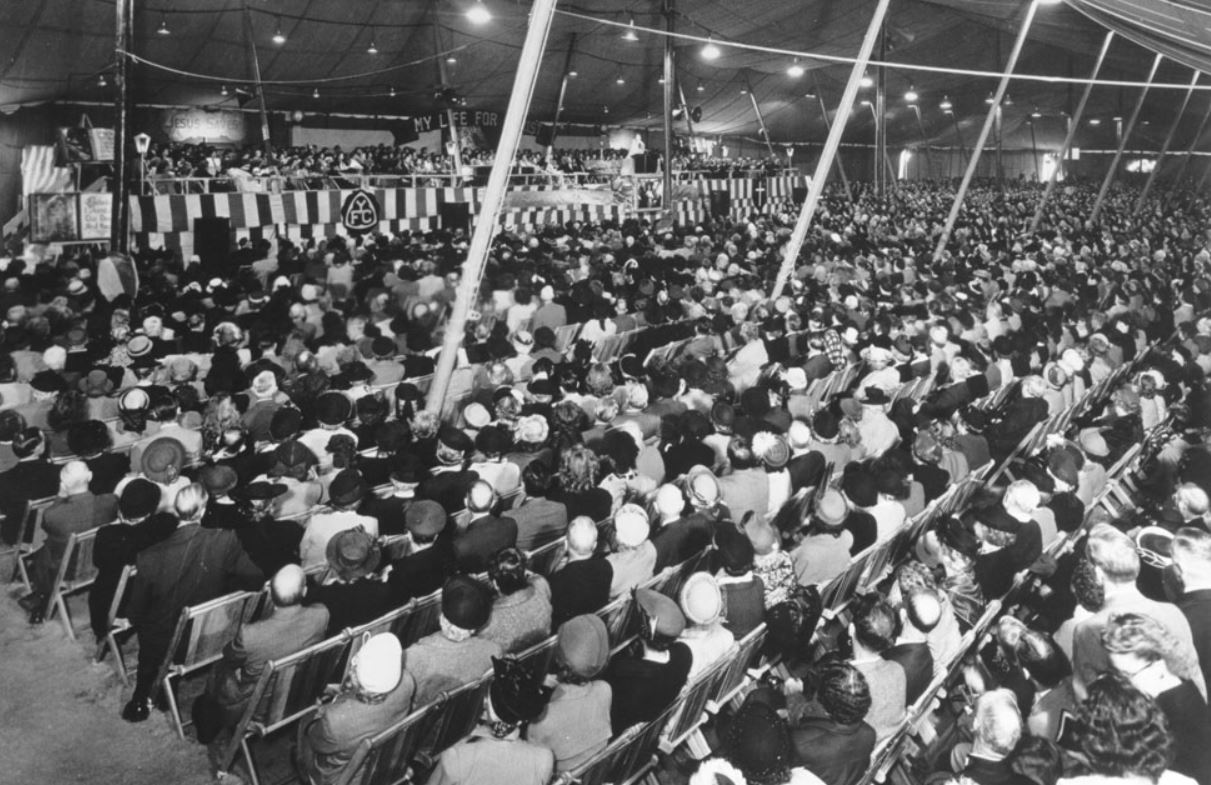
Inside the tent (called the “Canvas Cathedral”): Photo used with permission of BGEA. www.billygraham.org
The Media and the Evangelistic Event
The media gave the well-planned event little attention until some notable individuals became involved.

Newspaper advertisement after well-known individuals began to be converted to Christ
Stuart Hamblen
Hamblen was one of radio’s first singing cowboys, and he became a singer, actor, radio show host, and song writer. At this time he was in a backslidden condition, and he interviewed Graham on his radio show and told those listening to
Go down to Billy’s tent and hear the preaching, I’ll be there.
Hamblen did attend–sitting on the front row–but in anger stomped out of the meeting, as he had come under severe conviction of his sins. This happened a couple more times with Hamblen, and finally he went to Graham’s hotel at 4:30 in the morning on October 18th, where he gave his heart to Christ. Hamblen then gave his testimony on his radio show, as well as in the tent before those assembled, and the newspapers began to take notice of the revival.
Hamblen is the one who wrote the well-known songs, “It Is No Secret (What God Can Do)” and “This Ole House.”
Extending the Revival
Billy Graham had been looking for a sign from God about extending the services, and the conversion of Stuart Hamblen was the sign he was looking for. So the services were extended beyond the three weeks, and continued till November 20.
William Randolph Hearst
When Stuart Hamblen gave his testimony, the reporters were crawling all over the story. William Randolph Hearst, owner of two newspapers in Los Angeles and a number of others across the country, was said to have told his staff to
Puff Graham [that is, “make this story big”].
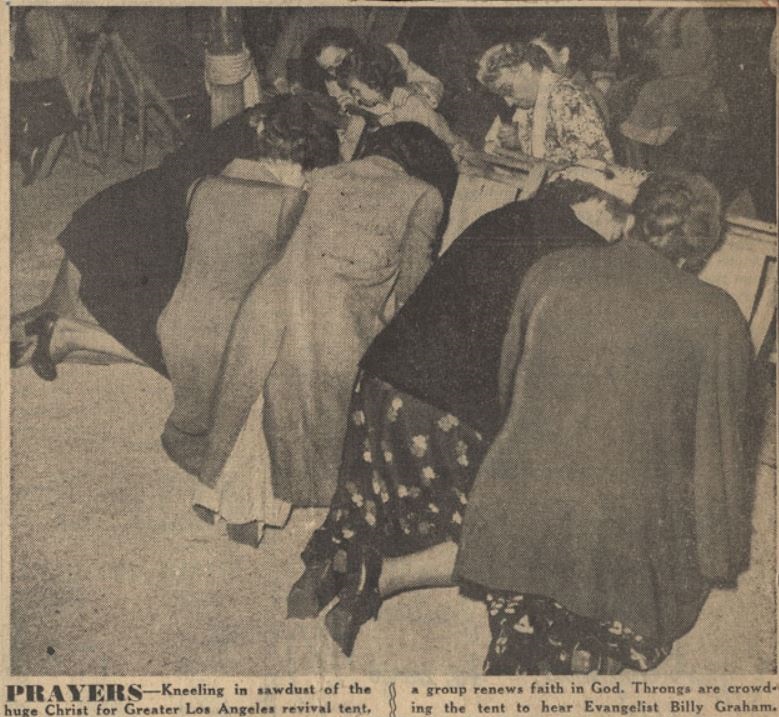
Kneeling in prayer during the revival
While the organizational committee had expected fifty conversions in three weeks, more than that were being converted every evening, and the newspapers were running this story because it was obvious that something unusual was happening.
All throughout Los Angeles, the revival services were the talk of the town, and headlines of papers were announcing:
OLD-TIME RELIGION SWEEPS LOS ANGELES
Time Magazine reported:
Bland, trumpet-lunged North Carolinian, William Franklin Graham, Jr., a Southern Baptist minister… His lapel microphone, which gives added volume to his deep cavernous voice, allows him to pace the platform as he talks, rising to his toes to drive home a point, clenching his fist, stabbing his finger at the sky, and straining to get his words to the furthermost corners of the tent.
Gangster Jim Vaus
Jim Vaus was a wiretapper for the high-profile mob boss, Mickey Cohen. Billy Graham had made several visits to his home, and this eventually led to Vaus’ conversion to Christ.
Louis Zamperini
Louis Zamperini recommitted his life to the Lord during the meetings. Zamperini was famous for having been an Olympic star. He was shot down in the Pacific Ocean during WWII, spent 47 days on a life raft, and was captured by the Japanese and mercilessly tormented by the notorious prison guard, Mutsuhiro Watanabe.
Harvey L. Fritts
Fritts was an actor whose conversion was announced by the media.
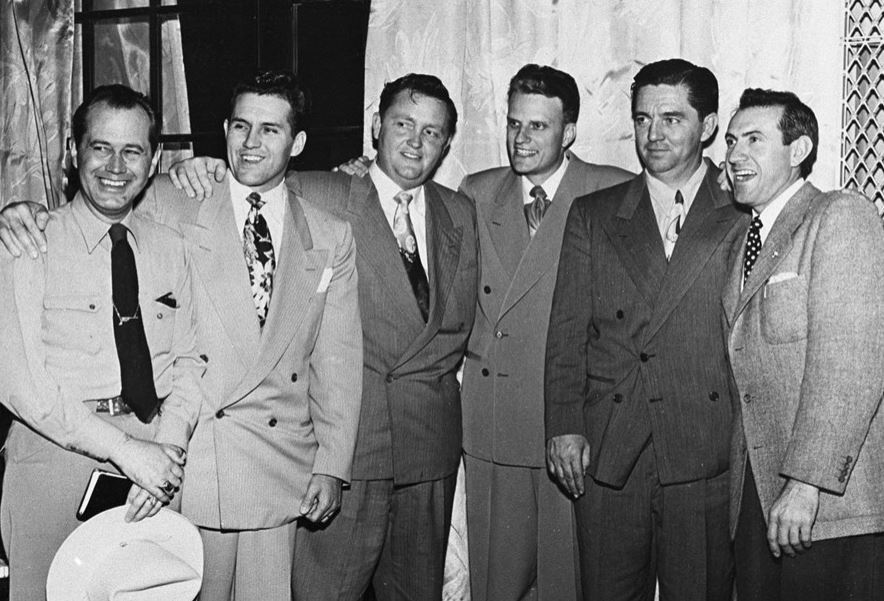
Lives changed during and after the revival (left to right): Harvey Fritts, Cliff Barrows (part of the Billy Graham team), Jim Vaus, Billy Graham, Stuart Hamblen, Louis Zamperini: Photo used with permission of BGEA. www.billygraham.org
Results of the Revival
► The Associated Press put out a daily press release on the events of the evangelistic campaign that was printed in almost every newspaper in America. The meetings went on for 8 weeks and thousands were converted, 82 percent of whom had never before made a profession of faith in Christ.
► The tent had been enlarged to seat 9,000, but on one night an estimated 12,000 – 15,000 sat and stood around the huge tent. Police said that they had turned away at least 10,000 more.
► The numbers who came forward for salvation reached totals of 200–300 per night. For every person prayed with, ten or twenty had to be addressed in a group because of the lack of workers.
► Marriages were being restored.
► This evangelistic event started fifty years of campaigns by Billy Graham, with millions making professions of faith in Christ. Every major city in America held a Billy Graham campaign, and he preached around the world as well. In 1973, more than one million in a single audience heard him in person in Seoul, South Korea.
► Mass media began to be used more extensively by the Graham team, as they founded Decision, a nationwide newspaper, as well as a radio and television broadcast called The Hour of Decision.
► Building on methods of previous evangelists like D.L. Moody, the Billy Graham Evangelistic Association developed the most comprehensive organizational structure ever used to reach a city for Christ, the structure of which began to be used by all evangelistic ministries.
► It helped spark revival around the world.

Locations where Billy Graham conducted evangelistic events during 1947-1950

Locations where Billy Graham conducted evangelistic events during 1951-1953
Between 1947 and 2005, Billy Graham conducted 417 crusades in 185 countries and territories on six continents.
Impact in Other Areas
► As denominations began to produce liberal or progressive literature, many independent Sunday School publishers began to produce Bible-based alternatives. In time, independent churches, as well as denominational churches, began using this material, rather than their own denominationally produced material.
► Dozens of new Christian liberal arts and Bible colleges were launched, all in response to the spreading liberal theology that was threatening to envelop the Church.
► Interdenominational agencies such as Campus Crusade for Christ began their ministries.
► New missionary agencies were founded
► Over 100,000 servicemen who saw the nations of the world during World War II were converted and trained, and then returned to spread the gospel around the world in one of the greatest missionary outreaches ever.
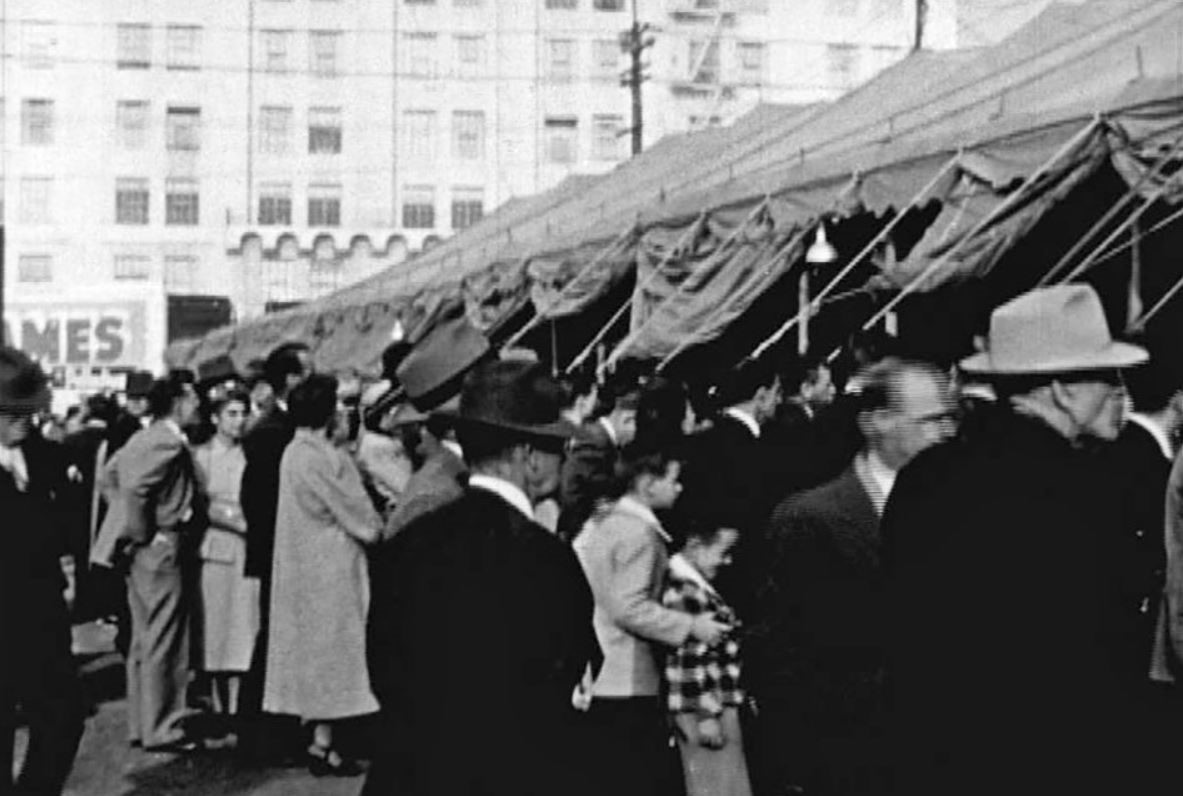
The tent had been enlarged to seat 9,000, but on one night, an estimated 12,000 – 15,000 sat and stood around the huge tent. Police said that they had turned away at least 10,000 more. Photo used with permission of BGEA. www.billygraham.org
Primary Sources
► A Prophet with Honor: The Billy Graham Story by William C. Martin
► Billy by Sherwood E. Wirt
► Billy Graham by Wikipedia
► Crusades: 20 Years with Billy Graham by John C. Pollock
► List of Billy Graham Crusades by Wikipedia
► Los Angeles Crusade (1949) by Wikipedia
► Olford Ministries Continues to Influence the World by Toni Lepeska
► The 10 Greatest Revivals Ever by Elmer Towns
► The Greater Awakening in Los Angeles by The Sunday School Times
► Unbroken by Laura Hillenbrand
Secondary Sources
► A Day in the Life of Billy Graham by Deborah Strober
► A Legacy of Faith: Things I Learned from My Father by Billy Graham
► America’s Pastor: Billy Graham and the Shaping of a Nation by Grant Wacker
► Billy Graham Speaks by Billy Graham and Janet Lowe
► Billy Graham, Evangelist to the World: An Authorized Biography of the Decisive Years by Charles J. Pollock
► Billy Graham, The Man and His Ministry by Mary Bishop
► Billy Graham: Candid Conversations with a Public Man by David Frost
► Billy: The Untold Story of a Young Billy Graham by William P. McKay
► I’ll Give You Rest by Harvey L. Fritts
► Just as I Am: The Autobiography of Billy Graham by Billy Graham
► Led to Believe by Anne Graham Lotz
► Madison Square Garden Crusade by Justin Taylor
► Ruth and Billy Graham: The Legacy of a Couple by Hanspeter Nuesch
► The Billy Graham Story: The Authorized Biography by John C. Pollock
► The Classic Writings of Billy Graham: Angels, How to Be Born Again, the Holy Spirit by Billy Graham
► The Faithful Christian: an Anthology of Billy Graham by Billy Graham
► The Legacy of Billy Graham: Critical Reflections on America’s Greatest Evangelist by Michael G. Long
► The Preacher and the Presidents: Billy Graham in the White House by Nancy Gibbs
► To All the Nations: The Billy Graham Story by Pollock, John Charles
Return to List of Revival Stories
Chet & Phyllis Swearingen:
Office: (260) 920-8248
romans1015@outlook.com
Beautiful Feet
P.O. Box 915
Auburn, IN 46706

